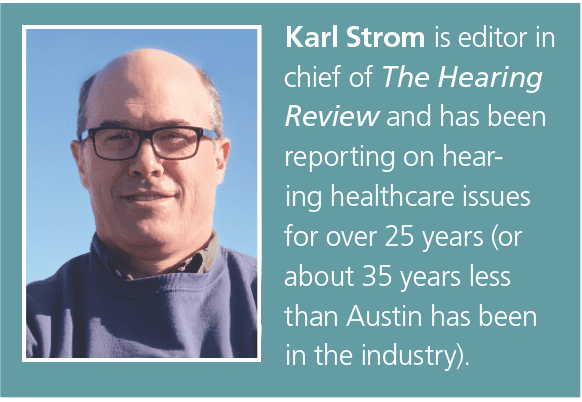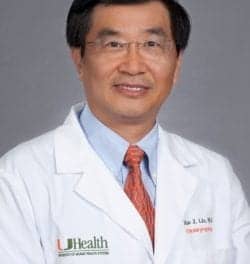Industry Insider | April 2021 Hearing Review
By Karl Strom
William (Bill) Austin celebrated his 60th year in the hearing healthcare field in February. As the founder of Starkey, one of the “Big 6” hearing aid manufacturers, he is probably among less than a handful of people who have continuously helmed a global hearing aid company from the 1970s to the present (the Tøpholms and Westermanns of Widex being the others I’m aware of).
With this impressive anniversary, Hearing Review thought it would be a great time to sit down and chat (via Zoom) with Austin:
HR: You’ve been interviewed by many people—including myself—over the years, and I thought this occasion would be a good opportunity to ask questions about what it was like getting into the hearing healthcare business in the 1970s and how you saw the industry grow, as well as your perspectives on some of the things you might be best known for as an innovator in the field. I know you’re a philosophical person, and you’ve always seemed to “live-and-breathe” hearing aids, while challenging yourself to get amplification into the ears of people who need it.
Austin: I am a philosophical guy, and I’m philosophically driven. Throughout my life, I was never really interested in money. It didn’t motivate me; instead, I decided why I wanted to work in the first place. And once I had that “why” firmly in mind, I was satisfied with what I was working toward—and I was good with it. That’s how I had the commitment to see things through until they worked out.
We’ve managed to grow through the years, and it has often been a slow growth that I would term as being earned by serving, not by necessarily being wise guys or outsmarting a lot of people.
HR: You bought Starkey in 1970. A lot of people talk about today as being a tumultuous time in hearing healthcare—and it definitely is. However, I think the 1970s were almost as tumultuous, with the Senate’s Church Committee hearings, the FTC interventions, Ralph Nader and the Gray Panthers, audiologists first starting to dispense hearing aids, and much more. In fact, there was a period in the 1970s where hearing aid units decreased from about 600,000 to 400,000 units—without a pandemic! Were there points when you thought, “Gee, what am I getting into?”

One of the first ads for Starkey hearing aids appeared on the back cover of the April 1975 edition of Hearing Instruments magazine, promoting the Starkey CE in-the-ear hearing aid with its 60-day trial period. It notes that “STARKEY produces more custom-made, in-the-ear hearing aids than the entire output of all types of in-the-ear hearing aids combined. STARKEY’s leadership is realistic because every unit is supplied with a 60-DAY TRIAL to the hearing aid specialist. The trial may be passed on to the individual fitted for 30 or 60 days; this method of hearing aid distribution is becoming more important every day.”
Austin: The industry was under a bit of assault in the 1970s. That’s true. And the only growth area—that was the area Starkey initially brought to the industry—was with the custom in-the-ear (ITE) products, which really did start pushing the [unit volume] numbers back up. Custom ITE hearing aids became the bulk of the products dispensed until they got overtaken by open-fit BTEs in the mid-2000s. Now we’re seeing ITEs coming back again, with rechargeable-in-the-ear hearing aids.
But, by 1970, I knew exactly what I got myself into, because it was in 1961 that I realized what my life’s work would be and why I wanted to be [in hearing healthcare].
HR: And that’s where your life-changing bus ride in Minneapolis comes in, right? Can you tell our readers about this?
Austin: Well, I had originally intended to become a medical doctor and get my degree from the [University of Minnesota-Twin Cities]. At the time I was driven by the story of Albert Schweitzer and his work in Africa. I was inspired by him. His respect for life resonated with me very deeply. He was a person I wanted to model myself after. So, I was very happy with that affirmation, and set out to become a physician. That was my goal in attending medical school.
And, because I was a college student and needed money for school, I took a job at my uncle Fred’s [Willoughby] hearing aid office, making earmolds—not hearing aids. And there was a gentleman named Chuck Strain who showed me how to make them. On my first day, he showed me how to make a couple earmolds and that was it; he walked away and went upstairs, because he was needed on the floor. They wanted Chuck to be selling hearing aids instead of eating dust, which was now my job.

Purchasing Starkey Labs in August 1970, Austin has grown the company from its humble roots as an earmold and all-make repair lab into one of the largest hearing aid companies in the world. In more recent years, he and his wife Tani have traveled the globe for their foundation, So the World May Hear.
So, I got the job of making earpieces. And I learned how to do it quickly, and I did it as well as I could. I started reading the books published by the National Hearing Aid Society, which was the forerunner of the International Hearing Society. They were establishing certification programs at that time. Fred ordered the program and didn’t want to do it, so he gave it to me. I read through it, and eventually ended up reading a lot more hearing-related books. At that time, I loved to read and I read a lot. So, I had started to develop a real understanding of [hearing and amplification], but still had every intention of becoming a missionary doctor; I wanted to save lives and do heroic things like Dr Schweitzer. At that time, I thought hearing aids were not as significant.
Then one day an old man came into the office with a profound loss. My uncle and the people upstairs in the shop couldn’t stop the feedback in his hearing aids. They couldn’t fit him. So, they called me to work on the earmolds. I saw the problem pretty quickly, and I had him hearing very well. But when I saw the look in his eyes of what it meant to him to receive that help, it hit me instantly. It was a profound moment. I was kind of in a state of shock, in fact. I couldn’t put it into words.
Work that day ended, so I got on a city bus to go back to where I was living. I sat on the bus looking out the window, and I knew I needed time alone to think and process the experience, right? Then I saw this quote [originally from Phillips Brooks] in the cantilever of the bus which said:
“The true way to be humble is not to stoop until you are smaller than yourself, but to stand at your real height against some higher nature that will show you what the real smallness of your greatness is.“
And I thought to myself, “Well, that’s the way I feel. I want to be challenged. I am not looking for the easy path; I want to do more.”
I went home, but my encounter with the older gentleman and that little quote haunted me. I went upstairs into my room, and I started talking aloud, just like I’m talking to you. And I said, “Bill, the reason you want to be a doctor is so you can help people. If you do this work, you will be able to help people, and you won’t kill anyone” (because I accept mortality as part of medicine). And I continued talking in this way for some time, and eventually I asked myself, “As a doctor, how many people can you help each day, Bill? Maybe 20 or 25 if you’re just doing quick examinations and [prescribing treatments]. It’s a relatively small number; you’ll spend your lifetime and you’ll impact one village—which is terrific. But, if you do this work with hearing aids, you can leverage your gift through the hands of many, and you’ll be able to impact the world.”
It seemed like an obvious choice to me: the world versus the village. I wanted to be part of a greater gift to humanity. And, really, it was at that point that I knew why I was going to work. The next thing I had to do was actually get there, right?

HR: So you purchased Starkey, an earmold fabricator—which was a subject area you had an expert understanding of—right?
Austin: Yes, but in truth, I started from nothing, and it wasn’t long before we had the world’s largest all-make repair lab. I purchased Starkey not because it was a particularly special or valuable company; it was because of Paul Jensen, a Danish gentleman who made their earmolds, which were superb. Harold Starkey had retired and sold his business to Paul, then headed north to Blackduck, Minnesota, with his wife. Harold left the entire business with Paul, and Paul was limited to the number of hearing aids he could make.
When I purchased Starkey, the business hadn’t grown in the preceding years; Paul just kept making about the same number of earmolds, which was barely enough to make a decent living. But Paul was an honorable guy and a craftsman, and he figured out how to make shells for the interior of aids, building them all nice and smooth inside. Before that, I’d been grinding them out. So, my main goal in purchasing the earmold lab was to get Paul. In fact, we continue today to make very refined earmolds for custom products because it’s serving a need that our customers have. [The earmold lab] never has been a big profit center—ever. But it’s a real service and a real skill area that distinguishes Starkey from the competition, because great earmolds are extremely valuable to both hearing care professionals and consumers alike. And they’re harder to produce consistently than you might think.
So that’s how I got into buying Starkey. I’m much more interested now in thinking about how we might do better, and becoming part of a future that allows us to provide a greater gift to humanity. That’s my motivation, and if you have your real motivation down pat, then things have a way of falling into place.
HR: I completely agree that you’re a person driven by your motivation and philosophy. But I was also a member of the HIA Statistical Committee with you in the 1990s, and I remember both you and [former Starkey Marketing Manager] Mike Bastyr always had those green-and-white striped computer reams tucked under your arms. At any given time, I could ask you and Mike any question, and you would come up with the numbers pretty quickly. So, I’m wondering if you give your “analytical side” proper credit?
Austin: Well, yes, but I didn’t like being given information that was incomplete and inaccurate. And, while at the time the HIA information we had was good, you’ll remember it was rather incomplete and could often paint a different picture of what was actually going on in the US market. I think if you want to make good decisions, you have to know the truth; you need to base your decisions on accurate information. So, I was always striving to get us more nuanced numbers.
HR: But you wouldn’t say you’re an analytical or “numbers type” of person?
Austin: No, I’m not a numbers person. I’m more like a person who flows wherever he’s needed at the time, right? If Starkey doesn’t have a problem in a particular area, then I don’t intercede; I don’t look at it, and I don’t even think about it. But if we’re having an issue, I try to understand that issue, talk to people, gather information and data, and I want to listen and look at the problem from different angles.
HR: I know you had involvement in almost all the facets of Starkey, including some of the product designs and innovations through the years. In fact, I’ve heard from many people who worked there in the 1990s that it was fairly common to find you in places like the shell or repair lab at 2 or 3 AM.
Austin: Yes, as you know, we’ve had many of the best engineers in the industry who made incredible contributions to the field, including people like Dave Preves and Bill Ely—just to name two. But, really, in the back room, I was working on individual problems that I found interesting and challenging, because I really wanted to help people.
And, in earlier days, a lot of the developments weren’t always made by big engineering teams. They were instead often made by technicians who were really good and innovative. Sometimes these folks were educated [in college] but probably just as many came out of places like the Navy, where they might have worked on radar systems or somehow obtained an understanding of circuitry—and even I came to understand the circuits because they were so bone simple back then.
We’d talk about things like how to increase dynamic range, or dream up how to make a power stethoscope which we then tested and worked on, or bone-conduction hearing aids that could be worn on the head for atresia cases. We made many, many different hearing aids, tinnitus maskers and masking aids, special-use devices, and a lot more—so many things were tried and done in the ‘70s and ‘80s.

Bill Austin addresses the audience at the 2016 Starkey Hearing Innovation Expo. Photo by Paul Willoughby, Jr.
HR: I’ve even heard that you made some attempts at a digital aid in the 1980s? I know we published an article by Veronica Heide about the Nicolet Phoenix digital hearing aid project in the 1980s which never came to commercial reality, so it’s interesting you were working on a digital aid at that time, too.
Austin: Yes, in fact, we were working on what would have been the first digital hearing aid in the 1980s. We were just ahead of the time and the technology. I could see what could be done with digital signal processing, but I was looking forward too far. So, you could say I was dumb, because if you work on something way before its time—before all the technological pieces are available—and you expend all that effort and money and you don’t get a return, you’d be correct in saying that’s not particularly productive. But I didn’t care; I had other people working on this, as well—an international team of three brilliant engineers, in fact—who put together the first digital algorithms. But it was way before its time in terms of commercial viability.
HR: But at least you can pat yourself on the back some for being perceptive about the future, right?
Austin: I don’t know if it’s so much being perceptive, as it is about wanting to be a big part of the future. I want to be the one who moves us into the future; I know if we can climb a little higher on the mountain, I can see tomorrow, and it’s going to be beautiful. I want to be part of that better future for the benefit of people. I know that if we can conceive it, we can achieve it.
However, it is a matter of timing. You can’t be too far ahead of the technology, right? You have to be there when [all the pieces come into place] and when it’s ready.
Today, the technology moves so fast, and our products have advanced so rapidly in the last 20 years. The early digital hearing aids were arguably no better than analog—if as good—but they were the necessary first steps for manufacturers. As they evolved, we started to be able to do more things with them, like managing feedback, occlusion, certain noise issues, and addressing many other important things. Our products got better and better, and they’re better today than they ever have been—by a long shot. And they’re going to get better still. We’re on that path.
Today’s path of innovation is so much faster now than it used to be. In the old days, we’d come out with new hearing aid models every 3-5 years, and some of the “big improvements” might have been a swing-out faceplate door instead of a pull-out one, or a slight product enhancement that resulted from cutting some new steel or retooling it. In those days, that might have constituted a “big step forward.” Today, no one would even mention anything like that—it has become an afterthought.
We are now in a race to do much bigger and better things, and bring incredible technologies to people’s ears that I could only imagine all those years ago.
Continue reading Part 2 of this 2-part article.

Citation for this article: Strom K. Philosophy of growth by serving people’s hearing needs: An interview with Bill Austin, Part 1. Hearing Review. 2021;28(4):26-30.
Correspondence to Karl Strom at: [email protected].





